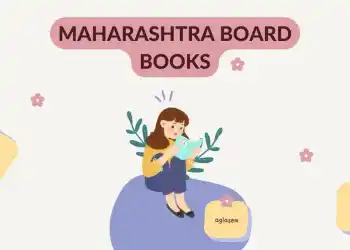Candidates can download NCERT Exemplar Class 6 Science Chapter 12 from this page. The exemplar has been provided by the National Council of Educational Research & Training (NCERT) and the candidates can check it from below for free of cost. It contains objective, very short answer type, short answer type, and long answer type questions. Along with it, the answer for each question has also been provided. From the NCERT Exemplar Class 6 Science Chapter 12, candidates can understand the level and type of questions that are asked in the exam.
NCERT Exemplar Class 6 Science Chapter 12 Electricity and Circuits
NCERT Class 6 Science Chapter 12 is for Electricity and Circuits. The type of questions that will be asked from NCERT Class 6 Science Chapter 12 are displayed in the below provided NCERT Exemplar Class 6 Science Chapter 12. With the help of it, candidates can prepare well for the examination.
Also Check: NCERT Solutions Class 6 Science
Multiple Choice Questions
- Choose from the options a, b, c and d given in Fig. 12.1 the figure which shows the correct direction of current.

- Choose the incorrect statement.
(a) A switch is the source of electric current in a circuit.
(b) A switch help to complete or break the circuit.
(c) A switch helps us to use electricity as per our requirement.
(d) When the switch is open there is an air gap between its terminals. - In an electric bulb, light is produced due to the glowing of
(a) the glass case of the bulb.
(b) the thin filament.
(c) the thick wires supporting the filament.
(d) gases inside glass case of the bulb. - In the following arrangement shown in Fig. 12.2, the bulb will not glow if the ends A and B are connected with
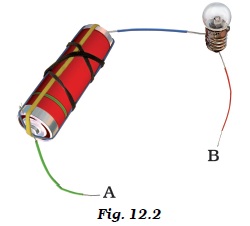
(a) A steel spoon
(b) A metal clip
(c) A plastic clip
(d) A copper wire - In the circuit shown in Fig. 12.3, when the switch is moved to ‘ON’ position,
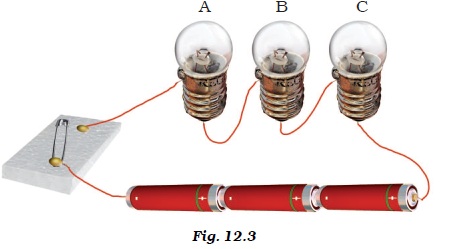
(a) the bulb A will glow first.
(b) the bulb B will glow first.
(c) the bulb C will glow first.
(d) all bulbs will glow together. - Filament of a torch bulb is
(a) a metal case.
(b) metal tip at the centre of the base.
(c) two thick wires.
(d) a thin wire. - Paheli is running short of connecting wires. To complete an electric circuit, she may use a
(a) glass bangle.
(b) thick thread.
(c) rubber pipe.
(d) steel spoon.
Very Short Answer Type Questions
- In which of the following circuits A, B and C given in Fig. 12.4, the cell will be used up very rapidly?
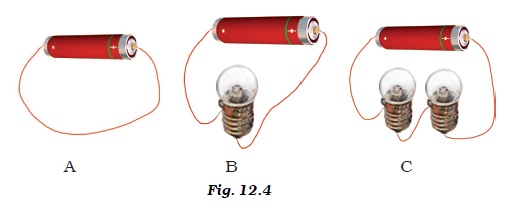
- Fig. 12.5 shows a bulb with its different parts marked as 1, 2, 3, 4 and 5. Which of them label the terminals of the bulb?
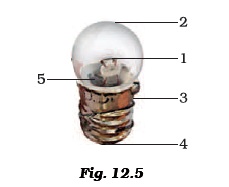
Short Answer Type Questions
- You are provided with a bulb, a cell, a switch and some connecting wires. Draw a diagram to show the connections between them to make the bulb glow.
- Will the bulb glow in the circuit shown in Fig. 12.6? Explain.
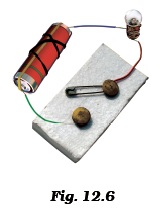
- An electric bulb is connected to a cell through a switch as shown in Fig. 12.7. When the switch is brought in ‘ON’ position, the bulb does not glow. What could be the possible reason/s for it? Mention any two of them.
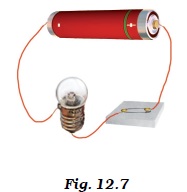
- A torch requires 3 cells. Show the arrangement of the cells, with a diagram, inside the torch so that the bulb glows.
- When the chemicals in the electric cell are used up, the electric cell stops producing electricity. The electric cell is then replaced with a new one. In case of rechargeable batteries (such as the type used in mobile phones, camera and inverters), they are used again and again. How?
- Paheli connected two bulbs to a cell as shown in Fig. 12.8.
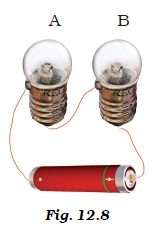
She found that filament of bulb B is broken. Will the bulb A glow in this circuit? Give reason. - Why do bulbs have two terminals?
- Which of the following arrangement A, B, C and D given in Fig. 12.9 should not be set up? Explain, why.
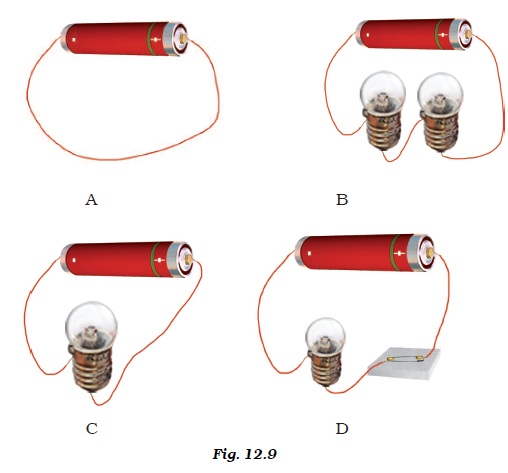
- A fused bulb does not glow. Why?
- Paheli wanted to glow a torch bulb using a cell. She could not get connecting wires, instead, she got two strips of aluminium foil. Will she succeed? Explain, how?
Long Answer Type Questions
- Boojho has a cell and a single piece of connecting wire. Without cutting the wire in two, will he be able to make the bulb glow? Explain with the help of a circuit diagram.
- Fig. 12.10 A and B, show a bulb connected to a cell in two different ways.
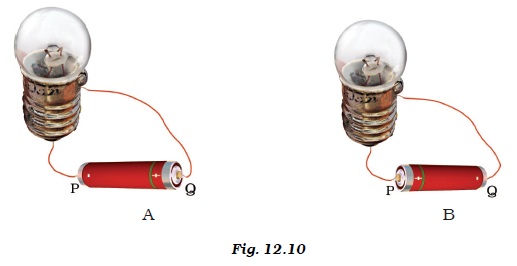
(i) What will be the direction of the current through the bulb in both the cases. (Q to P or P to Q)
(ii) Will the bulb glow in both the cases?
(iii) Does the brightness of the glowing bulb depend on the direction of current through it? - Think of six activities which use electric current. Also name the devices used to perform the activity.
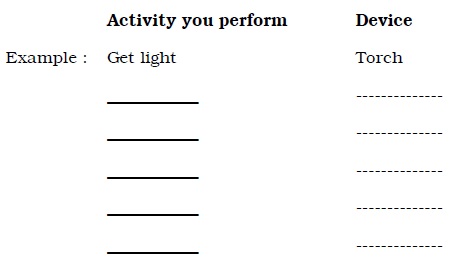
- A torch is not functioning, though contact points in the torch are in working condition. What can be the possible reasons for this? Mention any three.
Click here to download NCERT Exemplar Class 6 Science Chapter 12 Electricity and Circuits.
Answers


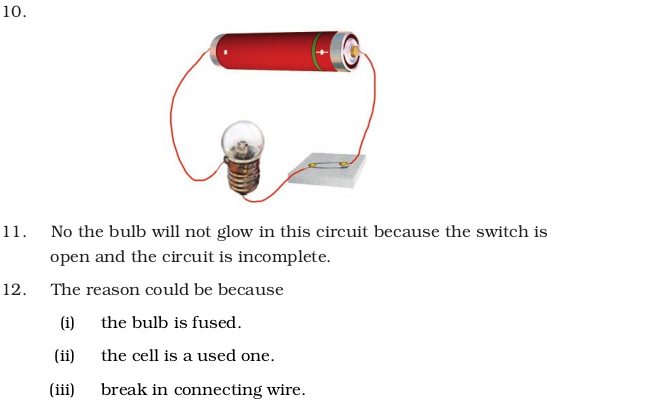



To get study material, exam alerts and news, join our Whatsapp Channel.
